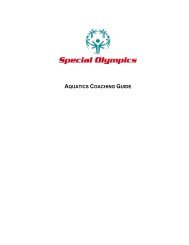Nutrition - Special Olympics
Nutrition - Special Olympics
Nutrition - Special Olympics
Create successful ePaper yourself
Turn your PDF publications into a flip-book with our unique Google optimized e-Paper software.
Understand measurable attributes of objects and the units,<br />
systems, and process of measurement.<br />
Solve problems that arise in mathematics and in other<br />
contexts.<br />
Apply and adapt a variety of appropriate strategies to solve<br />
problems.<br />
Recognize and apply mathematics in contexts outside of<br />
mathematics.<br />
o English<br />
Reading<br />
Read the worksheet. Have each food item labeled (next to the pictures<br />
and artificial foods, labeled beanbags, etc). Allow the student to place<br />
the food in the correct group only after reading the name of the food<br />
and the food group it belongs to.<br />
Students read a wide range of print and nonprint texts to build<br />
an understanding of texts, of themselves, and of the cultures<br />
of the United States and the world; to acquire new<br />
information; to respond to the needs and demands of society<br />
and the workplace; and for personal fulfillment.<br />
Students use spoken, written, and visual language to<br />
accomplish their own purposes (e.g., for learning, enjoyment,<br />
persuasion, and the exchange of information).<br />
Writing/Spelling<br />
Write the answers on the worksheet. Have the students make up the<br />
labels for the food groups as well as the foods. As an introductory<br />
activity, have students write down on paper their favorite foods, and<br />
their favorite fruit and vegetables, etc. During the class discussion, let<br />
them write what foods they mention on the board.<br />
Students adjust their use of spoken written, and visual<br />
language (e.g., conventions, style, vocabulary) to<br />
communicate effectively with a variety of audiences and for<br />
different purposes.<br />
Students apply knowledge of language structure, language<br />
conventions (e.g., spelling and punctuation), media<br />
techniques, figurative language, and genre to create, critique,<br />
and discuss print and nonprint texts.<br />
Students use spoken, written, and visual language to<br />
accomplish their own purposes (e.g., for learning, enjoyment,<br />
persuasion, and the exchange of information).<br />
8

















